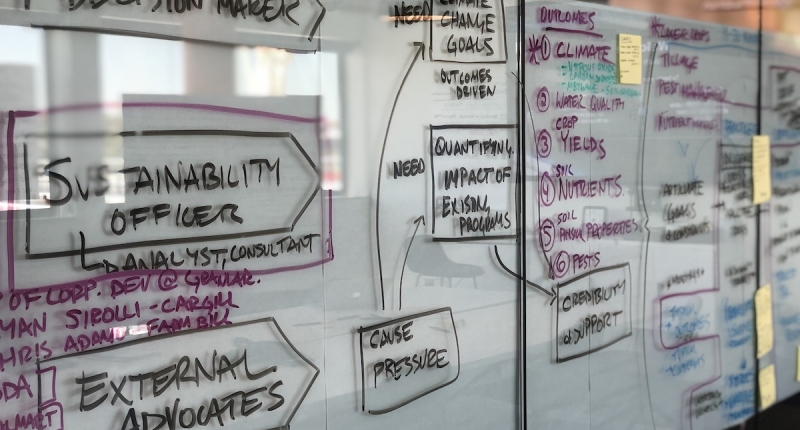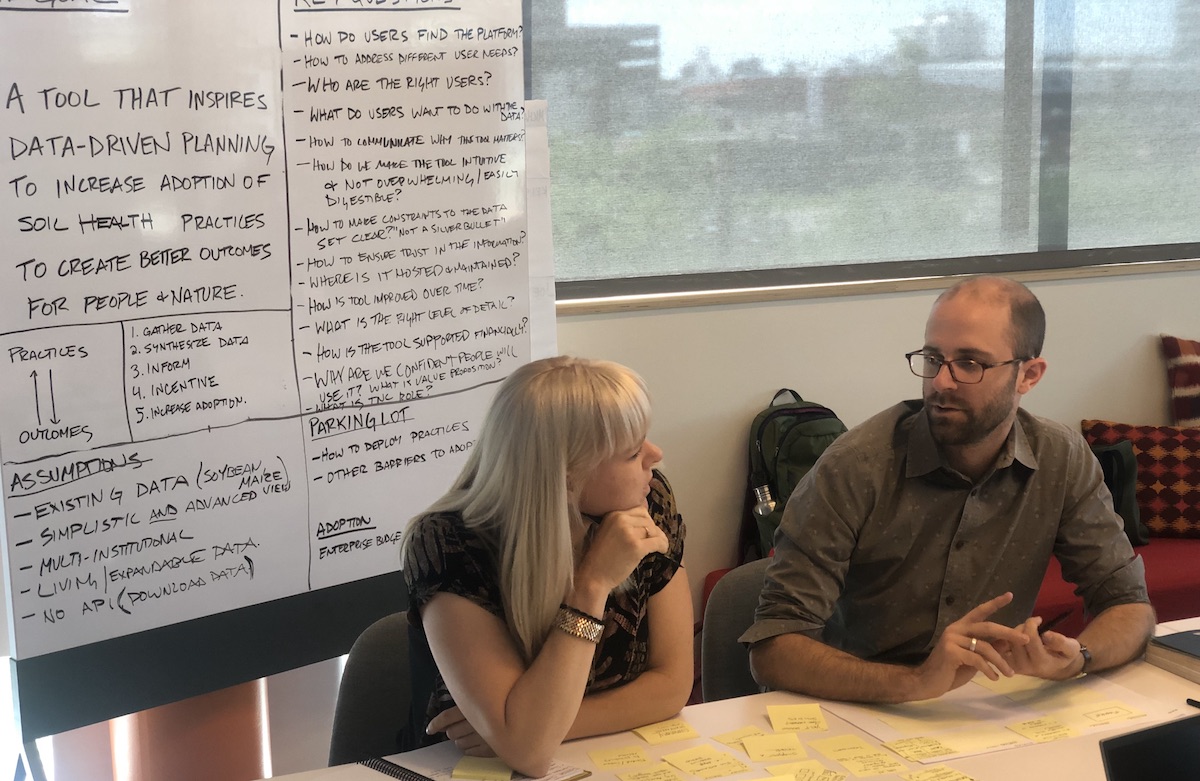Could Failing Fast in Conservation Science Lead to Quicker Success?

How to solve big problems and test new ideas in just five days – that may sound more like an infomercial from Silicon Valley than from science, and that’s not far from the truth. It’s the subtitle of a book called Sprint about an accelerated process of designing prototypes for tools, apps, and other innovations that has been used by the likes of Google and Slack, and it could also expedite solutions for conservation.
A design sprint is a “fail fast” method that is out of the ordinary for science – a discipline known for diligence, not speed – but in the right circumstances, it could give scientific teams a clearer and quicker path to success in turning their evidence into useful tools for improving nature and human lives.
The gist of a sprint is to gather a small-but-mighty group of people, stick them in a room for five or fewer days with no distractions, and follow a five-step formula for designing and testing a prototype that includes getting real-time feedback from intended end users.
Sprints are certainly not a new idea, but having recently participated in my first one, organized by a team of researchers from the Science for Nature and People Partnership (SNAPP), which NCEAS co-leads, I came out of it wondering whether there might be more room for it in science, particularly for collaborations that seek to apply their data and findings to decision tools and other ideas for environmental problem-solving.
The SNAPP team was actually a guinea pig for The Nature Conservancy’s* new Agility Lab, an initiative to apply tech thinking and tools, such as design sprints, to conservation to help scientists and others move more quickly to get ahead of the crises nature and people are facing.
According to the Agility Lab’s lead facilitator, Jessica Lybeck, who facilitated the SNAPP team’s sprint, the process is well suited for groups that are facing ambiguity around their next steps or are trying to kick off a project. It helps teams lean into the uncomfortable uncertainty around what the best solution might be.
“Sprints are a great tool to build something, get feedback, and iterate on it before you spend a lot of time and money on implementation,” explained Lybeck.
The efficiency of the process may be particularly important given that scientists and NGOs don’t have the same capacity or money-making drive to continually improve their projects as tech companies, who need to please their customers and make a profit. Finding the weak spots (or fails) in a prototype within five days is much better than spending two years and all your grant funding on a fully developed tool that doesn’t do what you hoped it would.
In the case of the SNAPP sprint, their new idea began with a huge dataset that clarifies the “state of the science” on which conservation farming practices, such as cover crops and nutrient management, provide which soil health benefits, such as storing carbon or improving water quality. The team wanted use the dataset to create a simple tool for agribusiness and policy professionals, the chosen target audience, who need hard evidence to design initiatives that encourage farmers to adopt conservation practices, but often don’t have it at their fingertips nor the capacity to synthesize it on their own.
In just two-and-a-half days, the team walked out with a prototype for a website that is like a NerdWallet for soil health practices. Just as NerdWallet helps its users sort through the dizzying options for credit cards, the soil health tool will allow its users to query which farming practices are associated with which soil health benefits or vice versa. This in turn will make it easier for them to know which practices they need to incentivize farmers to adopt – for example, if an agriculture company has climate mitigation targets, the tool will give them the data-driven case for incentivizing practices that store carbon.
“Sometimes you spend a lot of time in meetings and you feel like you don’t have anything to show for it,” said Stephen Wood, who leads the SNAPP team and is an applied scientist at The Nature Conservancy. “It’s cool to have something concrete that you can put out into the world.”

In a sprint, getting concrete quickly requires creating time and space for “deep work.” Smart phones and laptops are forbidden, and the team follows these steps to zoom out on the big picture before zooming in on their solution:
- Map the problem.
- Sketch possible solutions.
- Decide on the strongest solution.
- Prototype that solution.
- Test your prototype with actual target end users.
Aside from its accelerated pace, another important aspect of a sprint is the people involved – those who sit around the table and those from whom the team gets feedback on the prototype in step five. These participants should wear the sorts of hats that will help the project team create something that will meet the intended users’ needs.
“If the end user is not you, is not a scientist, it’s important to recognize that you need to talk to people outside of your frame of reference and include them in a process like this, and that what you might feel is best might not be the right thing for your stakeholder groups,” said Lybeck.
For the soil health team, participants included communications people (such as myself), data people, tech people, and the people who develop and promote soil health programs and incentives – the latter being the intended end user. In the testing phase, four potential end users were shown the prototype via a Zoom meeting and asked to give first-glance feedback on its utility to their work.
“Having those people added to the table will just increase the likelihood of your tool actually being used and providing the service that you intended it to,” said Lesley Atwood, a postdoctoral researcher on the soil health SNAPP team who was part of the sprint.
Atwood had spent a year and a half synthesizing the dataset underlying their prototype, a position that granted her the important role of the “decider” in the sprint process, the person tasked with making executive decisions when the group comes to a fork or an intellectual traffic jam.
The decider is a lynchpin for keeping things moving and making decisions rapidly. Lybeck explained that teams often find this rapid decision-making by a single person challenging, especially when decision-by-consensus is the more common model in collaborations – in our sprint, however, Atwood rarely had to wield her decision-making power, as the energy in the room seemed to flow in mostly the same direction.
“Decisions are progress,” said Lybeck. “In the sprint process, it’s more important for everybody to feel heard and to feel their ideas have been considered.”
The tangible progress the SNAPP team walked out with was a clear blueprint for a formerly fuzzy idea that they can now turn into a real-live tool, but that wasn’t all they took home with them. The process also built for them something that can be just as important as progress: confidence in the utility of what they are creating.
“The process provided a lot of clarity to me in things we can improve relatively easily, clarity in what problem it can actually resolve and who it can really help, and clarity in our next steps,” said Atwood.
“Scientists are rarely forced to really articulate who their user is,” said Wood, adding that being able to articulate what is valuable to a user – rather than to the scientist – increases the quality of both the science and how it is used to make positive change.
Indeed, by challenging scientists to think about how the final product will be adopted, Lybeck says sprints also help teams look beyond their work into the greater context in which it resides.
“[Looking] beyond is important, because it’s how the work that you do actually makes a difference,” said Lybeck.
For scientific teams wanting to reach beyond their normal toolboxes to try a design sprint, there were a few words of advice. Wood cautions to avoid getting mired in the weeds of your science, which can lead to conversation whirlpools that won’t go anywhere productive.
“Sometimes you have to suspend your scientific process,” said Wood.
Atwood says it is helpful to have something to work with at the beginning, such as the dataset they built their prototype around, and to make sure to get a good diversity of players around the table.
And despite the fact that the soil health team benefitted from Lybeck’s own professional facilitation skills, Lybeck asserts that anyone can do a sprint, with or without a professional facilitator, and the hardest but most important step to making it happen is simple: “Get one on the calendar.”
*The Nature Conservancy also co-leads SNAPP, along with NCEAS and Wildlife Conservation Society. Learn more at snappartnership.net.
